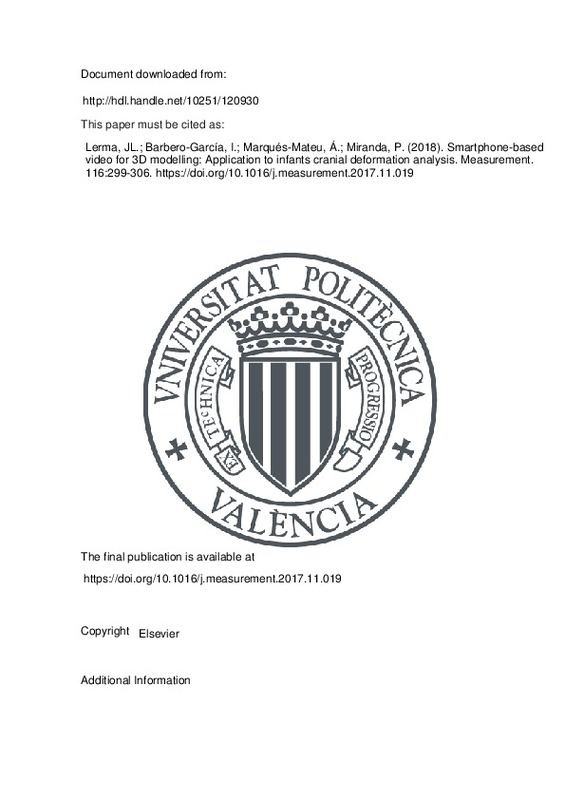JavaScript is disabled for your browser. Some features of this site may not work without it.
Buscar en RiuNet
Listar
Mi cuenta
Estadísticas
Ayuda RiuNet
Admin. UPV
Smartphone-based video for 3D modelling: Application to infants cranial deformation analysis
Mostrar el registro sencillo del ítem
Ficheros en el ítem
| dc.contributor.author | Lerma, José Luis
|
es_ES |
| dc.contributor.author | Barbero-García, Inés
|
es_ES |
| dc.contributor.author | Marqués-Mateu, Ángel
|
es_ES |
| dc.contributor.author | Miranda, Pablo
|
es_ES |
| dc.date.accessioned | 2019-05-22T20:28:44Z | |
| dc.date.available | 2019-05-22T20:28:44Z | |
| dc.date.issued | 2018 | es_ES |
| dc.identifier.issn | 0263-2241 | es_ES |
| dc.identifier.uri | http://hdl.handle.net/10251/120930 | |
| dc.description.abstract | [EN] The use of smartphones cameras for photogrammetric purposes is increasing. However, the suitability of smartphones for 3D modelling for medical purposes in general, and for cranial deformation in particular, is still to be analysed. This paper investigates the suitability of smartphone video cameras to create 3D models for cranial deformation analysis compared to the digital single-lens reflex (SLR) cameras traditionally used in close-range photogrammetry. Two models are obtained, the first one from a slow-motion video recorded with a smartphone, and the second one from SLR camera imagery. The models are compared to evaluate the differences not only between themselves but also through the best fitting ellipsoid that allow the determination of the cranial deformations. The average distance between models is 0.5¿mm, and below 1¿mm for 86% of the model points. The maximum difference between the two fitted ellipsoid semiaxes is 1¿mm. It can be stated that smartphones are a low-cost solution that can provide 3D models with a similar accuracy to that of SLR cameras for non-static objects in close range scenarios. More interestingly, slow-motion videos provide comparable results in real clinical conditions with infants in movement. | es_ES |
| dc.description.sponsorship | The authors acknowledge the partial support from the Subprogram C (No. C10) to the development of coordinated actions between the Universitat Politecnica de Valencia and the Hospital Universitari i Politecnic/Instituto de Investigacion Sanitaria La Fe. | es_ES |
| dc.language | Inglés | es_ES |
| dc.publisher | Elsevier | es_ES |
| dc.relation.ispartof | Measurement | es_ES |
| dc.rights | Reconocimiento - No comercial - Sin obra derivada (by-nc-nd) | es_ES |
| dc.subject | Close-range photogrammetry | es_ES |
| dc.subject | Medicine | es_ES |
| dc.subject | Evaluation | es_ES |
| dc.subject | Videogrammetry | es_ES |
| dc.subject.classification | INGENIERIA CARTOGRAFICA, GEODESIA Y FOTOGRAMETRIA | es_ES |
| dc.title | Smartphone-based video for 3D modelling: Application to infants cranial deformation analysis | es_ES |
| dc.type | Artículo | es_ES |
| dc.identifier.doi | 10.1016/j.measurement.2017.11.019 | es_ES |
| dc.relation.projectID | info:eu-repo/grantAgreement/UPV//UPV-FE-2015-C10/ | es_ES |
| dc.rights.accessRights | Abierto | es_ES |
| dc.contributor.affiliation | Universitat Politècnica de València. Departamento de Ingeniería Cartográfica Geodesia y Fotogrametría - Departament d'Enginyeria Cartogràfica, Geodèsia i Fotogrametria | es_ES |
| dc.description.bibliographicCitation | Lerma, JL.; Barbero-García, I.; Marqués-Mateu, Á.; Miranda, P. (2018). Smartphone-based video for 3D modelling: Application to infants cranial deformation analysis. Measurement. 116:299-306. https://doi.org/10.1016/j.measurement.2017.11.019 | es_ES |
| dc.description.accrualMethod | S | es_ES |
| dc.relation.publisherversion | https://doi.org/10.1016/j.measurement.2017.11.019 | es_ES |
| dc.description.upvformatpinicio | 299 | es_ES |
| dc.description.upvformatpfin | 306 | es_ES |
| dc.type.version | info:eu-repo/semantics/publishedVersion | es_ES |
| dc.description.volume | 116 | es_ES |
| dc.relation.pasarela | S\346856 | es_ES |
| dc.contributor.funder | Universitat Politècnica de València | es_ES |







![[Cerrado]](/themes/UPV/images/candado.png)

